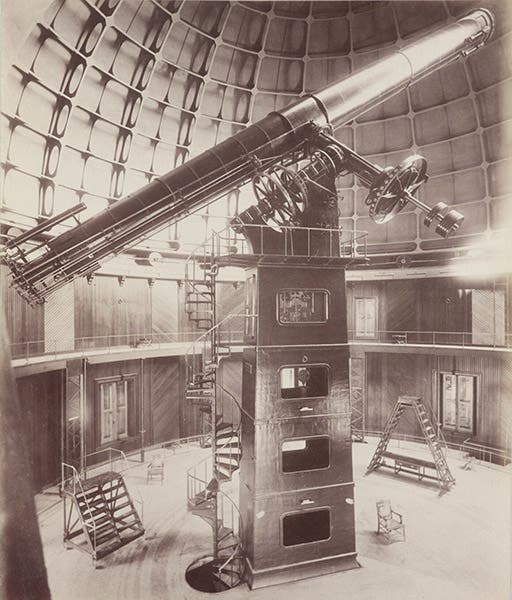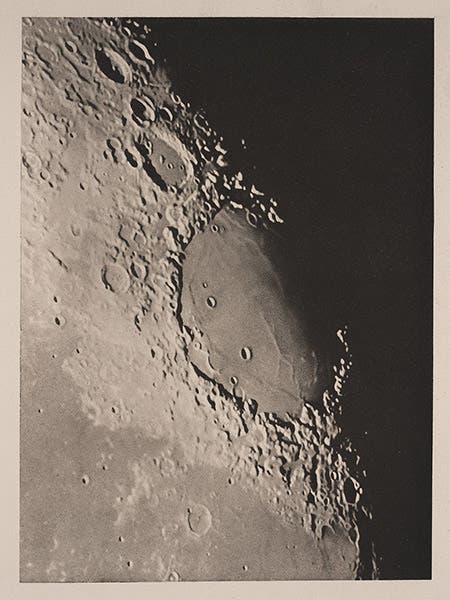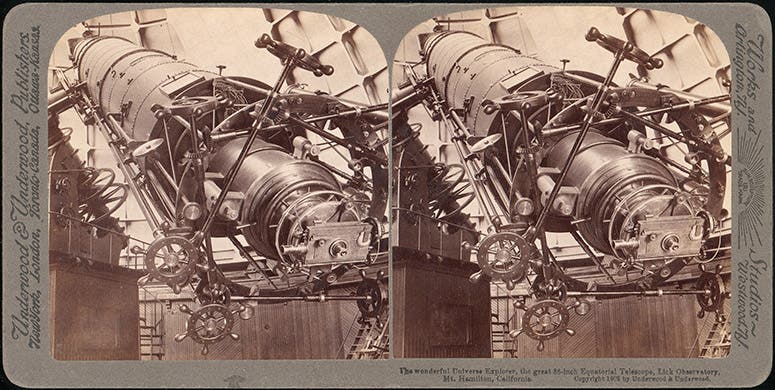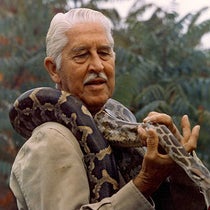Scientist of the Day - James Lick refractor
The 36-inch Lick refracting telescope saw its first light on Jan. 3, 1888, an astronomer’s way of saying that it opened for business and took its first photograph on that date. The telescope stood (and still stands) in a custom-made dome near the top of Mount Hamilton, an hour east of San Jose, California, and it was, at the time, the largest operational telescope in the world, with a pair of 36-inch lenses at the upper end of a 57-foot tube.
A whole series of large-lens refractors were built in the United States between 1863 and 1897. Nearly all of them sported lenses that were ground and figured by Alvan Clark & Sons in Cambridge, Mass., who produced a "world's largest refractor" nearly every time they fulfilled a commission. The U.S. Naval Observatory unveiled a 26" Clark refractor in 1873, and Pulkovo Observatory in Russia inaugurated a 30" Clark telescope in 1882. By this time, efforts to build the Lick Observatory, with an even larger refractor, were well underway. James Lick was a California real-estate magnate who decided to leave a large chunk of his sizeable estate to build an observatory with the largest telescope in the world. After he died in 1876, his executors began the slow process of readying Mount Hamilton for its gift hardware, a location favored by Lick because he could see the mountain from his ranch near San Jose. We published a brief post about James Lick back in 2017.
The Clarks, father and two sons, agreed to supply a 36" lens for the new telescope, which would indeed be the largest in the world. Actually, they agreed to supply two 36" lenses, one made of crown glass, one of flint glass. The two lenses, mounted a small distance apart in a metal cell in the upper end of the telescope, would correct the chromatic aberration that plagues single-lens refractors, and would provide an image without color distortion. They ordered the glass blanks from a firm in Paris, but one of the blanks broke in shipment, and it took the French firm 18 more casting tries to produce another bubble-free, crack-free 36" glass blank. Once they received the second blank in 1885, the Clarks did not take long to grind and figure the lens; it was ready in 1886. Soon it was making its way by train, with its cell-mate, from the east coast to the west, and then hauled up the mountain on a newly-made road by a mule wagon. We see below the lens cell after being unpacked at Mount Hamilton (third image).
The tube and mount for the lenses was supplied by the firm of Warner & Swasey in Cleveland. The tube was 57 feet long and 4 feet in diameter, and the mount that held the tube projected some 40 feet above the pier on which it sat. Encapsulated within the pier were the remains of James Lick, moved there when the pier was poured, as his will instructed. The dome in which the telescope and mount were housed had a moveable floor, with hydraulic pumps that would raise or lower the floor, depending on whether the telescope was pointed toward the zenith or closer to the horizon. We include a contemporary steel engraving of the telescope with the floor all the way down (fourth image).
The great advantage of the Lick refractor was the seeing. Nearly all previous telescopes had been built near sea level, and within cities, since that is where astronomers tended to live. Lick's executors wisely decided to build on a mountain top some 4000 feet above sea level, far from city lights and above any smoggy air. It was the first high-altitude observatory ever constructed. The seeing was so good that nearly every large observatory since then has followed suit.
The Lick refractor was not only the biggest telescope in the world, it was the best telescope anywhere, capable of taking photographs with more detail than any other on the planet. Edward Holden published his Observatory Atlas of the Moon in 1897, featuring photographs taken with the Lick refractor, photos that were unparalleled in their resolution. We have this atlas in our lunar collection and featured it in our exhibition, The Face of the Moon, and showed one of Holden’s photographs. We have another lunar atlas, containing detailed drawings based on Lick lunar photographs, assembled by Ladislaus Weinek and published from 1897 to 1900; we show one of those here (fifth image). Astronomer Edward Emerson Barnard used the Lick refractor to discover Almathea, the 5th moon of Jupiter, in 1893 – the first new Jupiter satellite discovered since Galileo spotted the first four in 1610.
The Lick refractor is also noted for occupying one of the most beautiful locations ever gifted to astronomers. It sits up there in the Diablo Range, above everything (except the real peak of Mount Hamilton, nearby). You have to drive up a long scary winding road to get there (built originally, remember, for mules). And when you arrive, you can see not only all the stars and planets you would ever want at night, but during the day, much of central California as well. On a clear day, you can actually see Half-Dome in Yosemite, 118 miles away. The photograph of Mount Hamilton at this link, under copyright, so that I could not include it here, captures all the wintry charm of the domes of Lick Observatory.
Nine years after the Lick refractor came into operation, in 1897, the Yerkes Observatory opened in Williams Bay, Wisconsin, with a refractor sporting a pair of 40-inch objective lenses configured by the Clark firm, and the short reign of the Lick refractor as the world’s largest refractor was over. But the James Lick refractor has continued in operation right down to the present day, although it is now surrounded by larger and more useful reflecting telescopes. If you are ever in San Jose with time on your hands, the 25-mile, hour-long drive to Mount Hamilton to view this historical telescope would be well worth your while. It would be even more enjoyable if you convinced someone else to drive.
William B. Ashworth, Jr., Consultant for the History of Science, Linda Hall Library and Associate Professor emeritus, Department of History, University of Missouri-Kansas City. Comments or corrections are welcome; please direct to ashworthw@umkc.edu.












